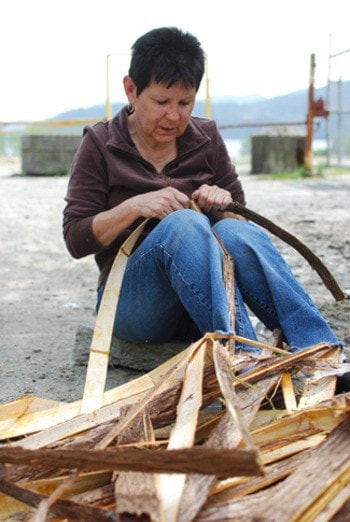With a pile of red cedar at her feet, traditional basket-weaving artist Kathy Edgar is at home.
The art of knitting was passed down to her by her grandmother, and the art of basket weaving was passed down to her by her mother. Edgar has, in turn, passed on her knowledge of basket weaving to her son, as well as those attending last month’s Heritage Days celebration.
Edgar, a member of the Nitinat Band, which is part of the Nuu-cha-nulth Nation, spent the day before her Saturday Heritage Days basket weaving demostration, collecting materials for the project.
One of the tricks to traditional basket weaving is in picking the right materials.
Edgar’s favourites are red cedar and swamp grass.
“It’s all natural reeds,” she said, of the green-onion-looking grasses.
Related to the selection of materials is being respectful of nature.
There’s a method to collecting bark so that no harm comes to the tree. If done properly, the bark is able to re-grow around the tree.
“You don’t totally strip the tree naked, and you don’t hammer into the tree,” she said, adding that she only takes two or three strips of bark per tree.
One should collect the bark right after the sap begins running.
“If you get it too late, it’s harder to peel and it’s really dry,” Edgar said.
As for swamp grass, most areas are protected sanctuaries, so it’s harder to come by. Edgar has a special permit for her collections.
The materials can then be dyed using commercial dye, Edgar said, and weaved into baskets.
“Living at Nitinat Lake, there’s not much to do, because it’s isolated there,” she said, of one of her inspirations to continue with basket weaving, after 28 years.
“It’s my hobby.”
